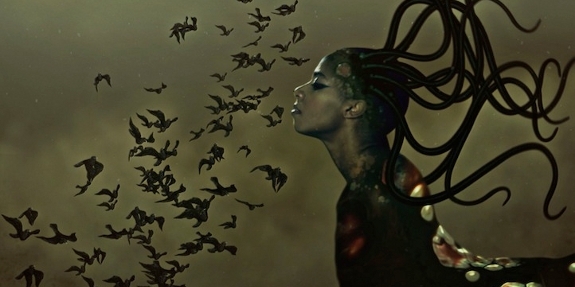Wangechi Mutu's magical wonderland
Kenyan artist Wangechi Mutu attacks dominant Western narratives, questions migration, borders, home and exile, exposes the monstrousness of overconsumption and portrays the capitulation of capitalism. The figures in the magical wonderland she creates inspire awe - and so does she.
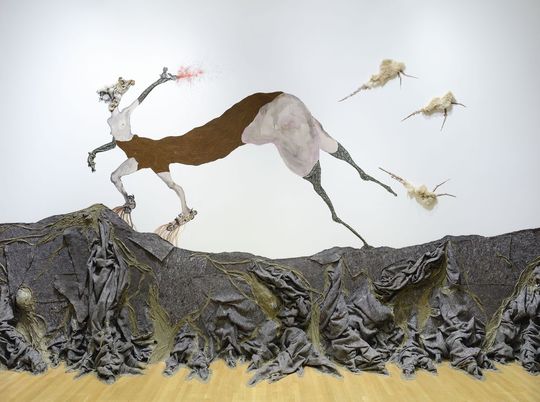
A centaur-like female figure advances up a hill of grey felt, her silhouette distinct against a background of smoky blue sky. She could be the sole survivor of an apocalypse. A trio of furry mechanical birds chase her like missiles, their thin canons pointing at her exposed backside. Her legs are brittle and her proportions absurd, her torso stretching thin between her chest and her fleshy backside.
Still, she carries signs of strength. Her chest, made of polished wood, can surely repel bullets, and her limbs, made of motorcycle parts, load her with horsepower. From her extended arm, she emits a small splatter of blood: a hint, no doubt, of the greater damage she could cause if provoked. The title confirms who is the victor here: Once upon a time she said, I’m not afraid and her enemies became afraid of her The End.
Mushrooms and stilettos
It is this image that greeted visitors at the entrance to Wangechi Mutu’s recent exhibition at the Brooklyn Museum in New York, USA. Comprising fifty works dating from the mid-1990s to the present, it offered a journey into the wondrous world that Mutu has been creating over the past twenty years. This is a world of princesses and monsters, primordial jungles and post-war cityscapes, where questions of gender, race, globalization, colonialism, capitalism and migration come together in fantastical compositions.
Like the woman in the opening piece, Mutu has had hardships to overcome. The title ‘A Fantastic Journey’ is also a reference to the (short-lived) 1970’s American TV series of the same name, which told the story of a family that was lost in a parallel universe and whose efforts to get back were thwarted by their inability to decipher the laws and borders of their new world. This story presumably strikes a chord with Mutu, who was born in Nairobi, schooled in Wales and has been living in the United States since 1992. After 9/11, the immigration gridlock kept her like thousands of others in limbo, unable to leave, for years.
As she often states in interviews, problems surroundings migration, borders, home and exile remain central to her practice. They are the themes of works like Riding Death in My Sleep. This collage shows one of Mutu’s signature hybrid women – in this case, with a white face and a multicoloured body that looks as if stained by acid rain – crouching on a globe covered in mushrooms. These fungi are the migrants of the world: those who settle in places most others refuse to go and survive, somehow, off fewer means than most could imagine. Mutu suggests that they are also those who bring new forms of life to the world’s stuffiest corners.
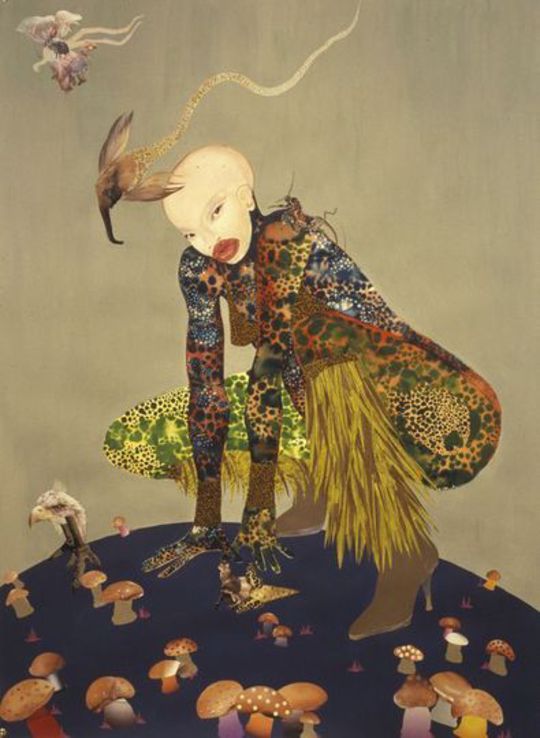
Mutu also critiques the ‘grand narratives’ of Western society: the stories the West has been telling itself, and the rest of the world, since the dawn of its ‘civilization.’ For instance, her 2005 Misguided Little Unforgiveable Hierarchies is a highly effective play on the West’s subordination of Africa. Three figures are stacked in a pyramidal composition. On the bottom, a dark-skinned, many-breasted woman crouches in the grass, looking upwards with mouth wide open into the face of another woman who is standing on her back. Lighter-skinned, thinner and nimbler, she is contorting her body backwards, sticking out her tongue at the woman below her. So focused is she on her derisive gesture, however, that she doesn’t seem to realize that a monkey-like creature is in fact riding and steering her, with eyes dead set ahead and motors revved.
Nor, in fact could she possibly notice that the black woman behind her has motorcycle parts for feet, and that she could probably take off from right under her stilettos. Now where exactly would that leave the Westerner? Mutu asks. Alone and face to face with the primal instincts that have been guiding her for centuries, it seems.
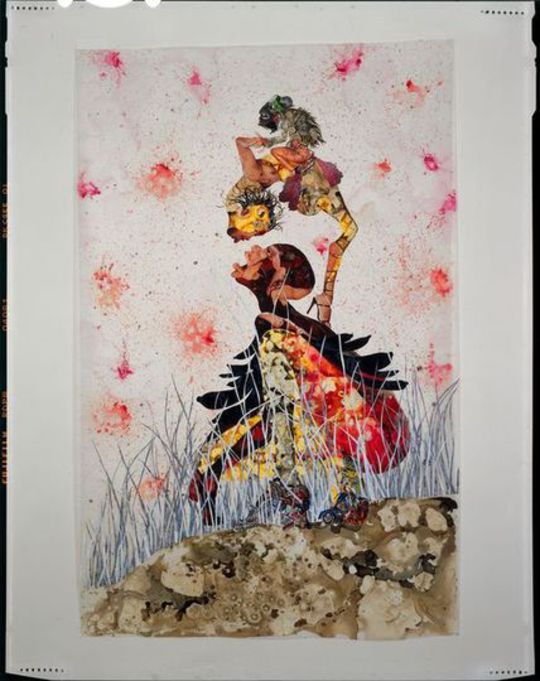
Strength from dismemberment
Mutu uses her scissors and glue to emphasize the strength that derives from dismemberment, the resilience that is developed through displacement, and the beauty that is difference.
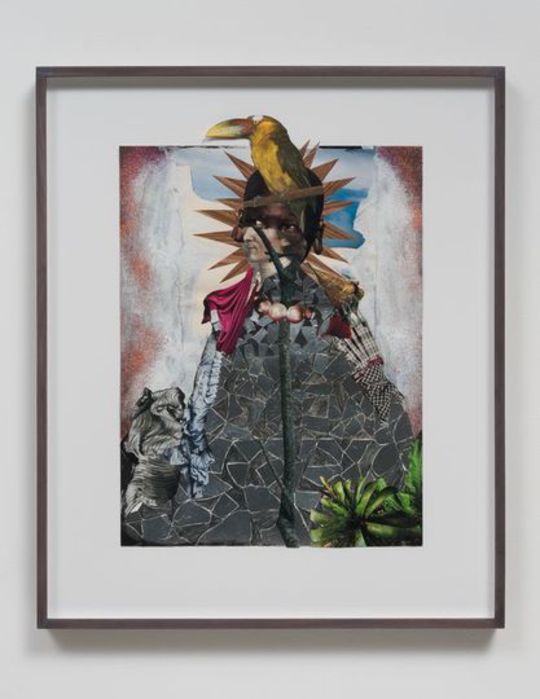
One of Mutu’s newest works is a family tree composed of thirteen frames, each bearing a portrait. Drawing on the Kikuyu creation myth, Mutu has placed two figures at the top: the moon and the sky. In the centre of the figures’ bodies, Mutu has pasted images of white-wigged men from 18th century prints. These allude to the indelible imprint of Western mores and cultural practices on identities in Africa and elsewhere. But she layers these images with cut-outs of feathers and leaves, arms and legs, machine parts and trees, showing ample possibilities for creative self-(re)definition.
Makeshift soccer balls
The themes of adaptation and regeneration are evident in Mutu’s creations in other media as well. In the installation Suspended Playtime, Mutu pays tribute to the creativity of children in impoverished regions of Africa and elsewhere. In the centre of the room, a cascade of black spheres hovers some inches above the floor. These garbage bags wrapped in twine are the makeshift soccer balls that children play with in alleyways and streets the world over. Using only the sparsest of means herself, Mutu here seems to ask us to consider what it is that makes life, like soccer, such a beautiful game.
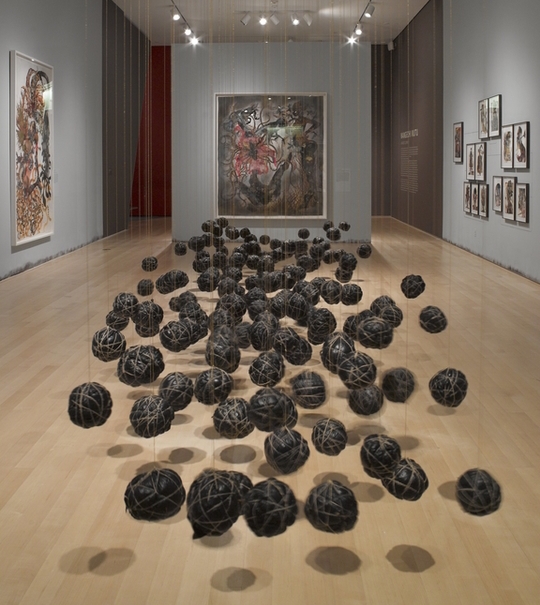
Transformation is also the subject of Mutu’s Amazing Grace, one of the three video works that were on display. The piece is a meditation on the slave trade; John Newton, the composer of the hymn, was an abolitionist. The video shows Mutu slowly walking into water and allowing her body to be carried by gentle waves. The camera cuts between close ups of her white linen dress rippling to the sea’s languid rhythm and wide angle views of her body drifting away across the ocean’s surface, calling to mind the many others that floated, swam and sank in the same Atlantic waters in centuries past. Played out to the soft melody of Newton’s hymn, these images of baptism evoke the pain of historical memory and the courage it takes to move into the future.
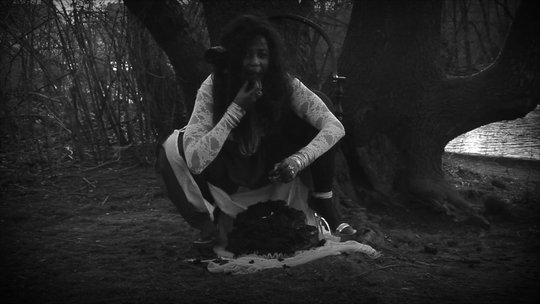
Let them eat cake
But for all her faith in the power of change, Mutu is also casting a weary eye on our common future. The two other video works on display deal with the theme of overconsumption. Set in a forest-like environment and shot in black and white, Eat Cake shows Mutu digging into a three-tiered chocolate cake with her bare hands. Although she is dressed in an immaculate white dress and her surroundings appear timeless, this is an emphatically modern woman: she wears tall, plastic stilettos, and the nails she uses to carve her cake are long, white, and fake. She is not entirely human, however. Like the figures in her collages, she crouches close to the ground, and devours the cake in a distinctly animalistic fashion. The title of the piece is a cheeky play on two familiar expressions – the vernacular “you can’t have your cake and eat it too,” and Marie Antoinette’s legendary “Let them eat cake,” the disdainful words the queen directed at a hungry people before their revolution devoured her in turn.
To emphasize the baseness of over-consumption and to highlight its links with globalisation, Mutu set up the projection not on the wall but on wooden crates stacked on the floor. Looking down at the grotesque ritual, the viewer is reminded that the West isn’t going to be able to continue eating its cake – let alone everyone else’s – for much longer.
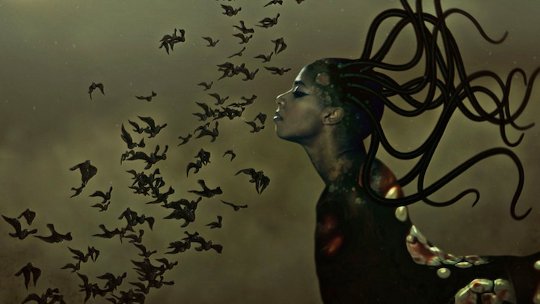
The End of Eating Everything is a sombre but spunky sci-fi commentary on the dangers of over-consumption. For the video, Santigold is transformed into a creature with the fangs of a serpent, the eyes of an Egyptian goddess and coils upon coils of Medusa-like black hair that flap behind her like the tentacles of octopi flail under the sea. In a reversal of the power relationships in Once Upon a Time…, The End of Eating Everything has the figure chasing a flock of crows, which she desperately tries to capture in her maw with grotesque bites into the air.
As the video progresses the angle widens and we discover that her body is in fact a gruesomely textured protuberance, which looks more like a magnified malignant tumour than like the body of any recognizable creature. Her body is covered with flailing human arms, poking through the industrial debris that is her skin. She is Mother Earth after the apocalypse, humanity after everything has been consumed – capitalism capitulated.
Noble savage
With these warnings in place, the exhibition ended as triumphantly as it began. In The Noble Savage, Mutu indulges the exoticizing imaginary more than usual, only to crush it all the more powerfully. Standing among tall grasses, the female protagonist reaches one arm high into the air and gazes upward to behold the fireworks of sparkling leaves and bejewelled ribbons that splay outward from her raised hand. She is no backward primitive stuck in a timeless past, but an allegory of the future in the same right as Santigold’s Medusa/Mother Earth. Her victory is the victory over prejudice and stereotype, over the barriers real and imagined that thwart contact, engagement and understanding between the world’s peoples. Empowered and free, she reminds the viewer that the categories of savagery and nobility belong to us all. And in that sense her emancipation is not only women’s nor Africa’s – it is our common liberation as a flawed, beautiful, and irremediably interconnected global community.
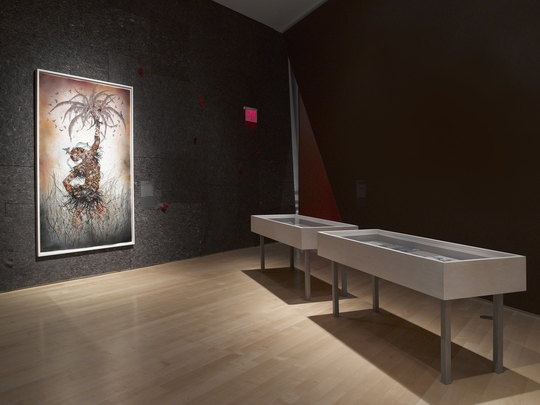
The collection ‘A Fantastic Journey’ was exhibited at the Brooklyn Museum, New York, between 11 October 2013 and 9 March 2014.
Lara Bourdin is ZAM Chronicle’s art editor.

